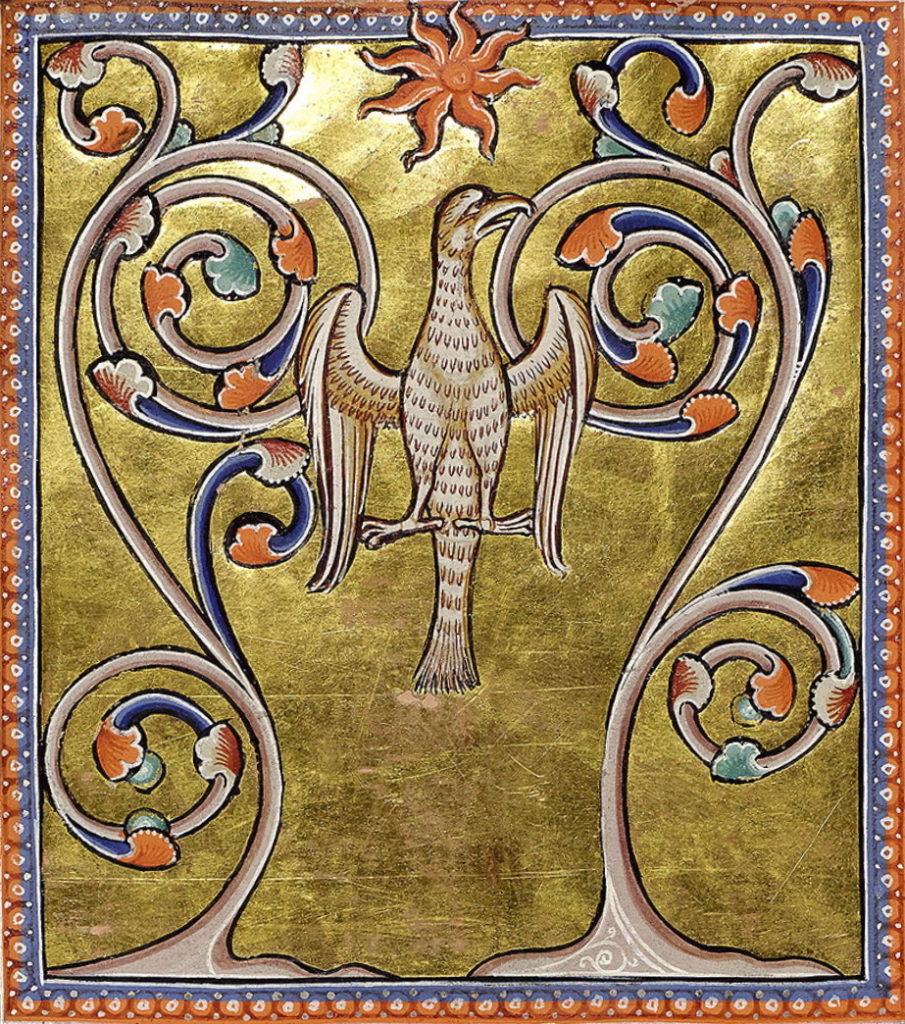As part of the Medieval Studies Research Blog’s ongoing Medieval Poetry Project, Richard Fahey offers a recitation and creatively translated section from the Exeter Book Phoenix (lines 85-119), which is titled “Phoenix of Paradise” because it characterizes the mythological phoenix and depicts its relationship to heaven, earth and the cycle of the sun.

Old English Phoenix (85-119):
ðone wudu weardaþ wundrum fæger
fugel feþrum strong, se is fenix haten.
þær se anhaga eard bihealdeþ,
deormod drohtað; næfre him deaþ sceþeð
on þam willwonge, þenden woruld stondeþ.
Se sceal þære sunnan sið behealdan
ond ongean cuman godes condelle,
glædum gimme, georne bewitigan,
hwonne up cyme æþelast tungla
ofer yðmere estan lixan,
fæder fyrngeweorc frætwum blican,
torht tacen godes. Tungol beoþ ahyded,
gewiten under waþeman westdælas on,
bideglad on dægred, ond seo deorce niht
won gewiteð; þonne waþum strong
fugel feþrum wlonc on firgenstream
under lyft, ofer lagu locað georne,
hwonne up cyme eastan glidan
ofer sidne sæ swegles leoma.
Swa se æþela fugel æt þam æspringe
wlitigfæst wunað wyllestreamas,
þær se tireadga twelf siþum hine
bibaþað in þam burnan ær þæs beacnes cyme,
sweglcondelle, ond symle swa oft
of þam wilsuman wyllgespryngum
brimcald beorgeð æt baða gehwylcum.
Siþþan hine sylfne æfter sundplegan
heahmod hefeð on heanne beam,
þonan yþast mæg on eastwegum
sið bihealdan, hwonne swegles tapur
ofer holmþræce hædre blice,
leohtes leoma. Lond beoð gefrætwad,
woruld gewlitegad, siþþan wuldres gim
ofer geofones gong grund gescineþ
geond middangeard, mærost tungla.
“Phoenix of Paradise”: A Modern English Translation by Richard Fahey
Translator’s Preface
“The woods are guarded by a wondrous fair fowl,
strong of feathers,
which is called the phoenix.
There the lone-wanderer beholds the land,
the brave-minded bird abides.
Death never scathes him in that wish-land
as long as the world stands.
He shall behold the journey of the sun
and again come toward God’s candle,
eagerly observe the glad gem,
when the noblest of stars comes up,
rises from the east over the sea-waves,
the father’s elderwork,
shimmering with jewels,
the bright token of God.
Stars are hidden,
sunken under waves in the westergulfs,
overshadowed in red dawn and the dark night,
they vanish pale.
Then the strong-feathered fowl,
proud of journeys,
eagerly looks out
upon mountain stream,
under air,
over lake,
when up comes the sky’s shine,
gliding from the east
over the wide sea.
So the noble fowl,
at the water-spring,
dwells sublime,
by the welling streams,
where the enlightened bird bathes himself,
twelve times in that river,
ere the coming of that beacon,
the sky’s candle,
and every so often
from that alluring, welling spring
the brimecold fortifies him with each bath.
Since he heaves himself after the water-play,
high-minded,
upon a far branch,
thence he may most easily behold
the voyage upon the easterways,
when the sky’s taper,
the light’s shine,
shimmers harshly over the thrashing water.
Lands are bejeweled,
the world enlightened,
since glory’s gem,
most celebrated of stars,
over the ocean’s surge,
shines upon the ground
throughout middle-earth.”
